||| FROM SEATTLE TIMES |||
ORCAS ISLAND — During the peak of this summer’s tourist season, Orcas Island seemed to attract just about everyone — except the workers who make it run.
Posted on the entrance of Enzo’s Caffe and Gelateria in downtown: “Our summer staff is going back to school! With the island labor shortage, we’ve been unable fill those positions. As such, we’ve made the difficult decision to [be] closed on Fridays.”
Across the street: “Due to the current labor shortage Pizzeria Portofino is only able to offer takeout service at this time. Thank you for your understanding.”
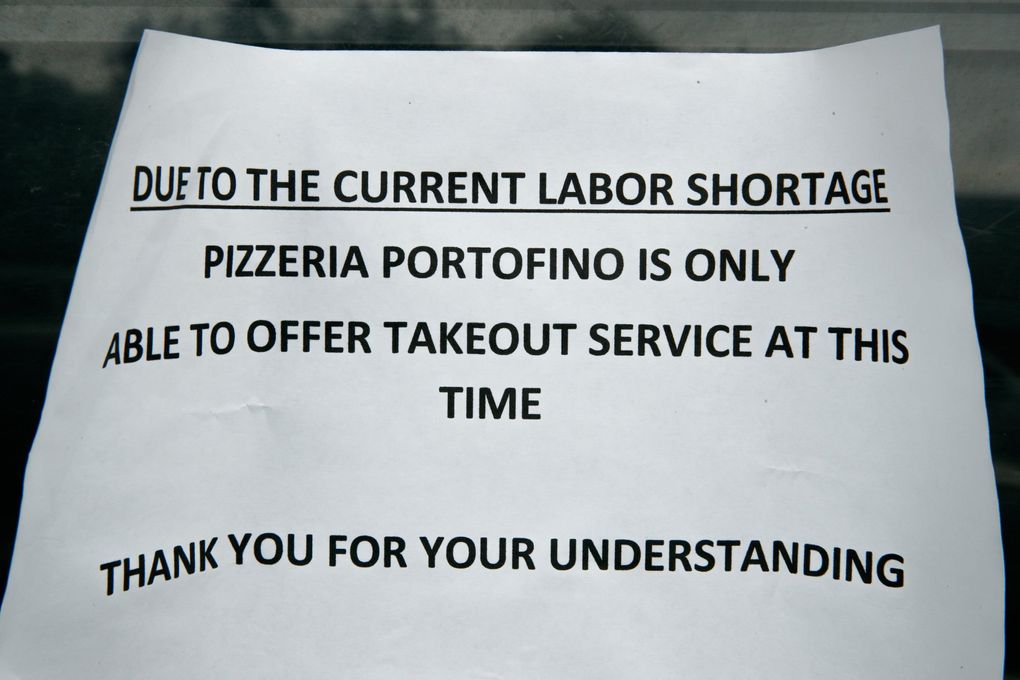
A sign at Pizzeria Portofino, in Eastsound, Orcas Island, on Thursday. (Erika Schultz / The Seattle Times)
Nearby, the sign posted at Hogstone’s Wood Oven restaurant, about 90 minutes after it opened for takeout with a skeleton crew, read “sold out.”
One exasperated visitor, after wandering around Main Street, turned to his wife and kids and asked, “Where the hell are we gonna eat now?”
For a classic Pacific Northwest tourist town that has always been a hot ticket in the summer, the pandemic-induced travel fervor has complicated life for restaurateurs who face a shortage of both labor and affordable housing. These restaurant owners have been able to find workers off the island. They just can’t find anywhere to put them up. Worse, even as we approach Labor Day, which usually marks the end of tourist season in the San Juans, the tourist surge shows no sign of slowing. Despite a statewide spike in coronavirus infections and cuts in frequency of ferry service to the San Juan Islands, hotel rooms are filling up fast in October, a month that’s usually a slow period.
Worker shortage meets tourist season for the ages
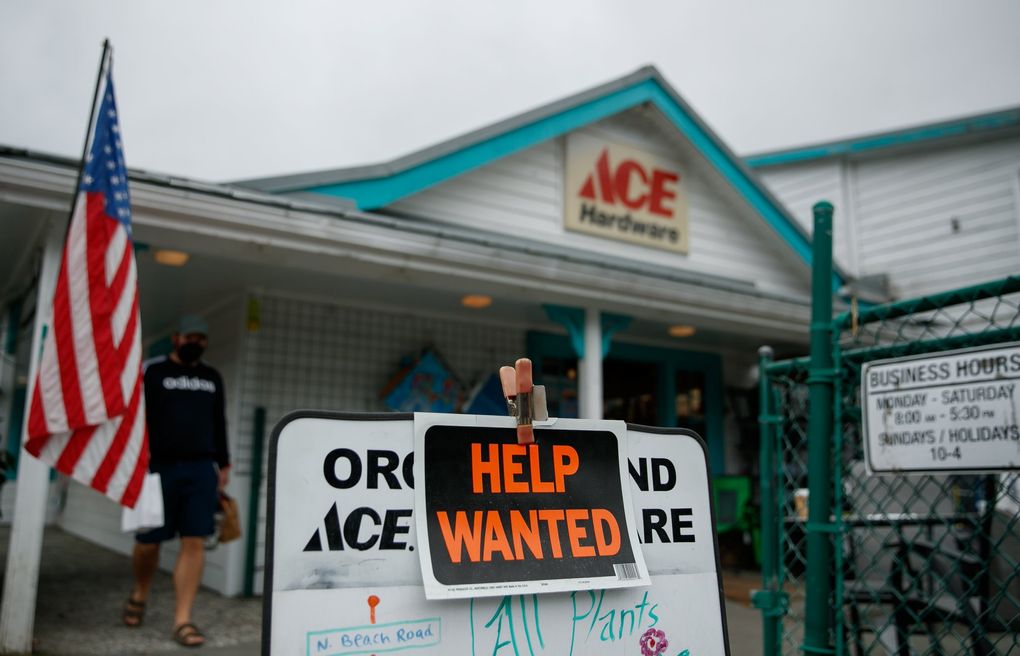
A sign at Orcas Island Hardware in Eastsound is seen on Thursday. Locals at the hardware store say many stores and restaurants struggle with finding full-time workers and housing for them. (Erika Schultz / The Seattle Times)
Just as in Telluride, Colorado, and other resort towns, the lack of affordable housing on Orcas Island — Oprah Winfrey recently sold her estate on the island for $14 million — means restaurants have had to cut lunch or dinner service and cap the number of customers in dining rooms so their understaffed crew can keep up with orders.
The flood of tourists is unusual. According to the Washington State Department of Transportation, this year’s monthly ridership on the main ferry route from Anacortes to Orcas Island, when looked at year over year, has, in some months surpassed ridership numbers from 2019. And that’s with one fewer ferry in service.
Lance Evans, executive director of the Orcas Island Chamber of Commerce for 15 years, said he has never seen this much tourist traffic and doesn’t foresee it tapering off since most hotels and other lodging have been booked far beyond Labor Day this year.
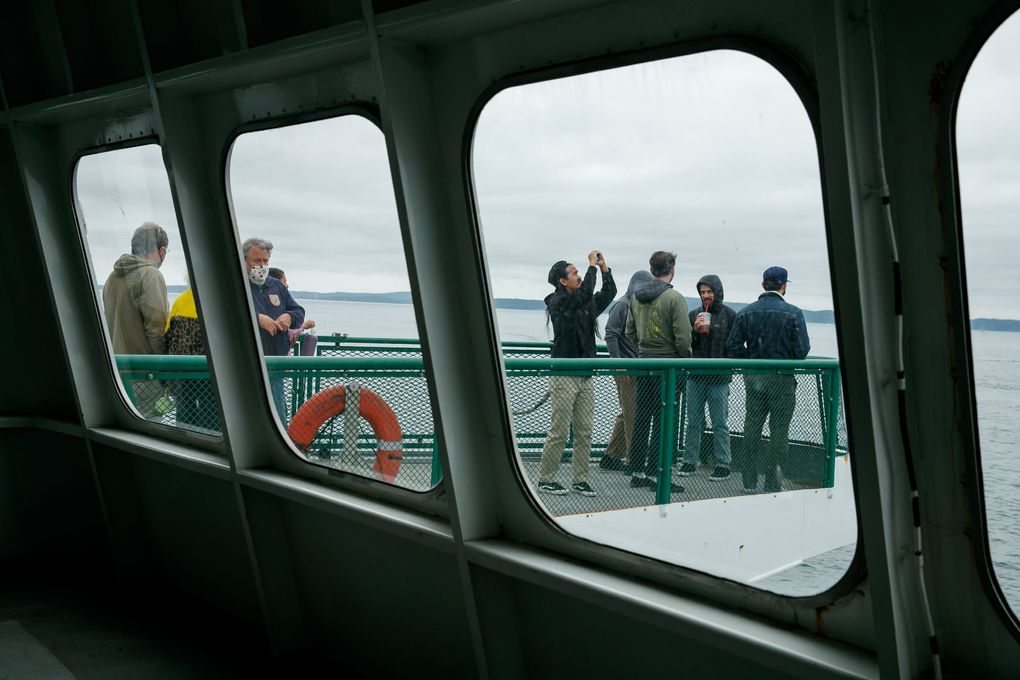
Crowds take the ferry from Anacortes, Wash. to Orcas and Shaw Islands Thursday, August 26, 2021. (Erika Schultz / The Seattle Times)
An informal Seattle Times survey of 10 bed-and-breakfast inns and hotels on Orcas Island showed that 90% of rooms have already been reserved through mid-October.
At Moran State Park and Mount Constitution, the top tourist attraction on the island, park rangers report that the number of day park users increased 15% from May to July (the latest figure available) compared with the same period before the pandemic. All campsites are booked through Labor Day weekend and also filling up for the rest of October at a faster rate than in the past, park rangers reported.
One camper, Michelle Roberts of Edmonds, says that in the 25 years that she has frequented the San Juan Islands, she has never experienced a labor shortage this bad.
“There were fewer restaurants [open]. Meals took longer to be served. There were dirty tables,” Roberts said, adding that servers “couldn’t seat customers. They were so understaffed, they couldn’t get to everybody. They were stressed out, they were so overworked.”
The restaurants are indeed struggling under the strain. At times, the owners of Matia Kitchen & Bar in Eastsound felt like the entire fleet of tourists had descended upon their dining room.
Drew Downing and Avery Adams, alums of the nationally acclaimed Hogstone’s Wood Oven restaurant, and two other co-owners, launched their farm-focused Matia Kitchen & Bar in May.
Their dining scene was hectic but got more frantic after New York Times food columnist J. Kenji López-Alt dined at the restaurant in June and tapped this shoutout to his 400,000 followers on Instagram: “This is the best, most exciting restaurant I’ve been to in at least a decade or longer. I can’t remember being so blown away by the food and wine program … Local food and casual dining at its finest.”
After that rave, Matia’s reservation line crashed overnight, overloaded by 200 voicemails. About 40 people filled the parking lot the next morning to get a jump on the lunch line. This became Matia’s Groundhog Day. The constant ringing of the phone could have doubled for the background music during service.
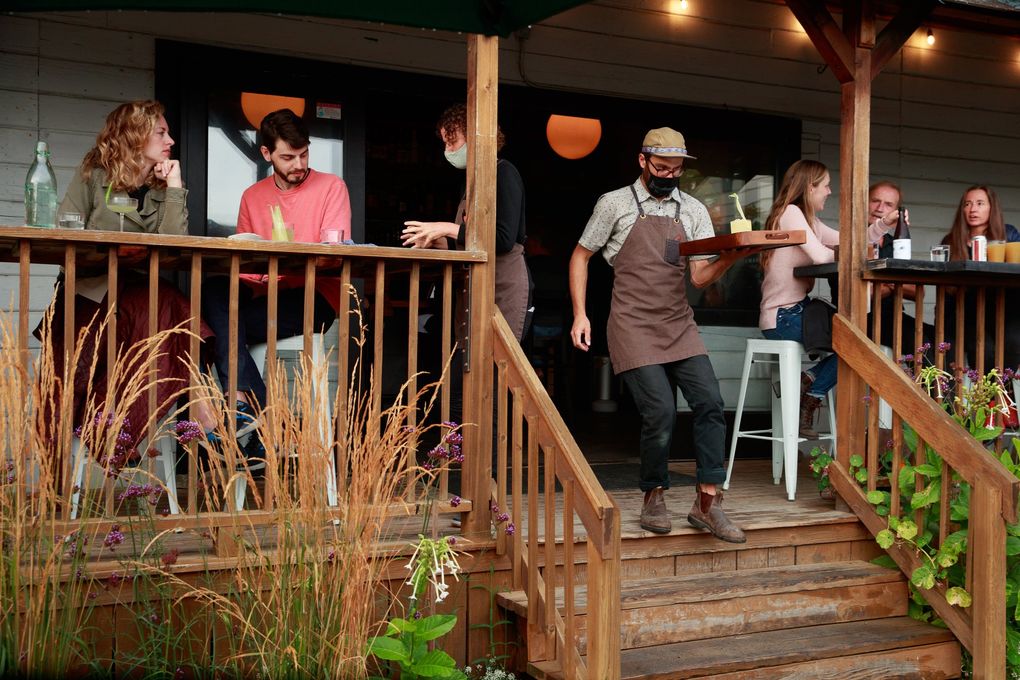
Traffic has only increased at Matia Kitchen & Bar in Eastsound, Orcas Island since a New York Times writer extolled it on social media. (Erika Schultz / The Seattle Times)
Of course the buzz came at a time when Matia was short two cooks, two dishwashers, two bussers and a host. Co-owner Downing filled in on many of those roles. His staff scrambled and sweated during lunch and dinner service.
“I was in a freefall. For the first time, I lost control of my restaurant,” Downing said. “People say this is a good problem to have. [But] if guests have to wait for their food, that’s not a good problem for them. And that makes it a problem for us.”
Downing took out 30 of the 90 restaurant seats and turned away diners to slow the pace.
“Of course you lose money,” by taking tables away, he said. But “this is not a cash grab. I’m not going to sacrifice the customer experience for the bottom line. We are not Red Lobster.”
Three blocks east of Matia sits the other heralded restaurant in town, Hogstone’s Wood Oven, headed by Jay Blackinton, whom Food & Wine magazine anointed one of the best new chefs of 2017.
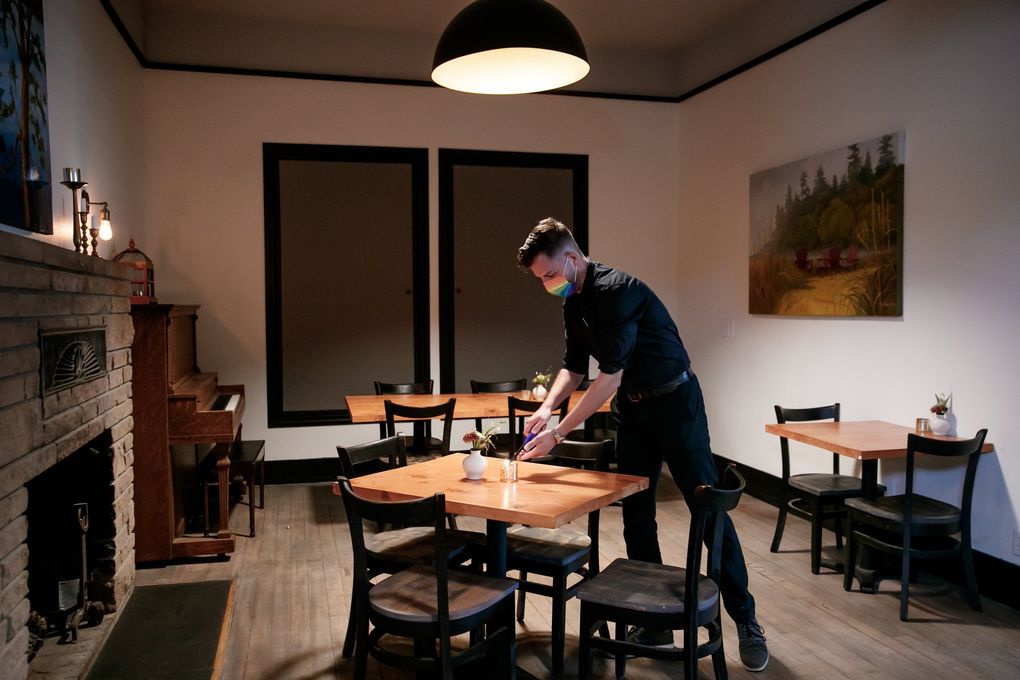
Tim Coffey, dining room manager at Matia Kitchen & Bar in Eastsound, Orcas Island. (Erika Schultz / The Seattle Times)
Both Matia and Hogstone’s share a server who recently handed in her notice and is moving to London. Because neither restaurant can replace her, Hogstone’s will likely just offer takeout going forward, while Matia will shut down its lunch service on weekdays, management at both restaurants said.
No housing, no workers
Orcas isn’t immune to the labor shortage that has plagued Seattle and other metropolitan areas. But in years past, Orcas restaurateurs could always eke out a kitchen staff with the sales pitch of an island paradise and the lure of $350 in tips on nights during tourist season. This year, many restaurateurs said they had lined up cooks and servers from around Washington and Oregon only to lose them because of “no vacancy” signs on the island.
The crisis is so dire that Downing gave up his two-bedroom apartment to two new employees while he lived out of his car for a while, just so he would have enough staffing to open this summer.
“I needed employees more than I needed a house. That decision seems like a no-brainer,” Downing said.
**If you are reading theOrcasonian for free, thank your fellow islanders. If you would like to support theOrcasonian CLICK HERE to set your modestly-priced, voluntary subscription. Otherwise, no worries; we’re happy to share with you.**

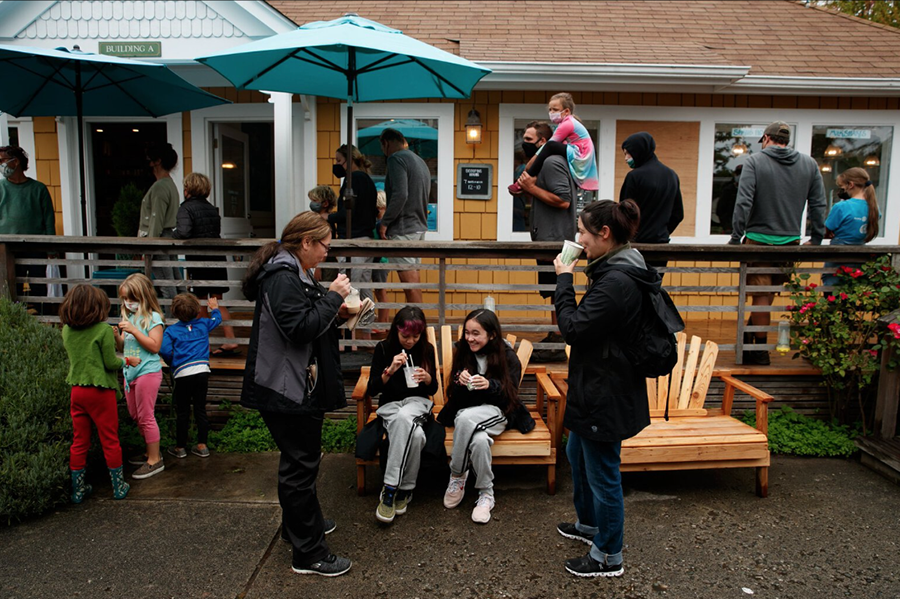


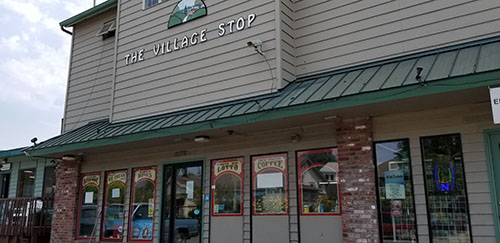

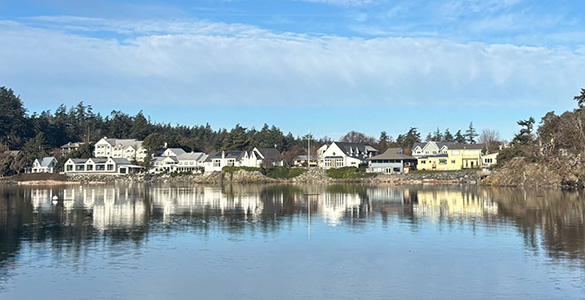


I was talking to my brother Bill today on his 72nd birthday. Until his retirement a few months ago, he was a local judge for more than three decades in Salida- a glorious place in southwestern Colorado.
He has seen a lot of changes similar to what we have experienced in San Juan County:
As Salida become a retirement and tourist mecca, housing prices rose to levels unaffordable by ordinary working folks. In times past, particular businesses may have had a problem finding employees, but the situation has gotten much, much worse in recent years. New employees can find nowhere affordable to live.
As income inequality has risen, the local housing problems only have increased. Colorado had their own Tim Eyman-like fellow who led a tax revolt that has hamstrung revenues at state and local levels.
I do not know exact solutions to our affordable housing issues in the San Juan Islands, but I know that I do not want to live in a community that feels it is ok for people to lack a place to live.
We need to discuss solutions and then act.
Today’s Seattle Times story on Orcas labor problems and the availability of housing ( or lack ) might help shine a light on the causes…..how out of date our permit regulations…our zoning code…our antiquated housing restrictions contribute to the shortage of service personnel and the housing they require and deserve.
It is time to admit that our building permit process is broken.It is broken by lack of staff in Friday Harbor as well as hamstrung by regulations that discourage or even prohibit creation of rental housing units.The resultant delays in permit approvals is also driven by the complexity of meaningless petty restrictions that restrict building new units.
Example : ADU s must be located within 100 ft. Of the main building….WHY ?
ADUscant have kitchens and can’t be rented out ( legally)…WHY ?
The difficulty of obtaining a zoning change is daunting to say the least.Restricting home lots of over 2/3 acres to only one residence unless you are near Eastsound…is directly impacting the creation of new housing units.The result….more units built without permits or….built under the radar….substandard units…fire traps…inadequate plumbing….
Would it not be better to allow ADU ( with kitchens) creation to be built WITH PROPER INSPECTION AND MONITORING and allow long term rentals
Oh oh, Tony; a few misstatements.
ADU’s whether attached or detached can have kitchens, and most do….mine included. It’s the non-permitted living units that, according to restrictions, can’t. One can have as many itchenless ( no stove)) structures can be on a property, and be called “studios” and other mentionable definitions. This is to protect the single living unit structure of ost of the lots on this island, except in commercial areas.
Being no farther away than 100 ft., I’ll grant you is a restriction that makes no sense until you put it in perspective with the other aspects of the Friends of the San Juans’ blockades they put up when these regs were being decided.
ADU’s must be no more than a certain size and have the same septic and water system as the larger house. The intent was to restrict “sprawl”. Having the structures close to each other in my mind creates more of a ‘build-out”, “mcMansion” appearance than a smaller structure tucked in the property corner.
While I have you, the one reg I totally disagree with, and feel is unfair, unjust, possibly illegal, and every other description you can think of, is that if you have a DETACHED ADU (forget the attached) permitted after 2007, you CANNOT get a VR permit for it…ever; again, control of increase VRs, which was jumped on at the time as logical. As you say, Tony, WHY???
I love my typo in the 3rd line!!
The problems causing the current lack of affordable housing and long-term rentals in SJC are multi-tiered, and are not relevant to just housing issues… there are no easy solutions. But, with all that we know now, realize that allowing you to rent the second home on your property as a short-term vacation rental (Margot) would not, in any way, help rectify either SJC’s current lack of affordable housing, or lack of available long-term rentals.
The root of the housing problem (beyond a continued lack of political will), is multi-layered, and is not one that can be solved by simply building more housing. I mean, we’re having a banner year for home sales, new home construction, and the numbers of tourists flocking to our shores… all at the same time. A win-win, right? Evidently not. Though county zoning and regs desperately need to be attended too in an effort to create more year-round rentals and more affordable housing, the basic fact (the baseline) is that we don’t have a “housing shortage” in SJC… we have a “tourist economy” which has resulted in a proliferation of outside interests investing in 2nd homes, (to the tune of more than 50% of SJC’s entire housing market), and also apprx. 1,000 short-term rental permits.
In Elizabeth Becker’s “Overbooked” 2nd home ownership by outside interests is akin to “foreign ownership”. She spells it out succinctly when she says, “Either you control tourism, or it controls you.”
Water…..Tony seems to think we have an endless amount of it here. We don’t.
Thank-you, Michael Johnson!
Your analysis clearly describes our dilemma:
“Though county zoning and regs desperately need to be attended too in an effort to create more year-round rentals and more affordable housing, the basic fact (the baseline) is that we don’t have a “housing shortage” in SJC… we have a “tourist economy” which has resulted in a proliferation of outside interests investing in 2nd homes, (to the tune of more than 50% of SJC’s entire housing market)…”
Doing more of what got us here in the first place will not help to provide the housing our communities need to support the services and amenities that we all demand.
One more reason to re-read or read for the first time ‘Living and Working in Paradise’.
And how the requirement of beds in a tourist economy is at least partially solved by Whistler.
Tony Ayer makes a fine point about the missed opportunities of ADUs as affordable housing. Many will remember the “guest house ordinance” of 2007, brought about by a lawsuit by the Friends of the San Juans and others, imposed these restrictions on ADUs, which had formerly been a matter of right for all property owners. The one sensible thing that came out of that ordinance was that ADUs, now restricted and permitted by lottery, are prohibited from being vacation rentals. If guest houses were allowed universally, but only for family, friends or long-term rentals, we could go a long way toward increasing our rental housing supply.
Bea,
I am planning to read “Living and Working in Paradise”.
Janet
Top review from the United States
Carol Winstanley
5.0 out of 5 stars A heartfelt thanks for this wonderful book.
Reviewed in the United States on November 23, 2015
Excellent; I live on Waiheke Island, New Zealand which fits into the detailed picture of a failed market that Hettinger has given us. The information on what’s to be done is very valuable to the Housing Group that is presently being formed on the Island. Thanks to the Author for the work that he has done, which will contribute enormously to how we are able to proceed.